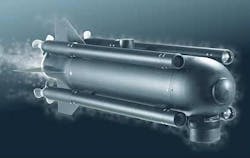Navy looks to Lockheed Martin, Atlas Elektronik, for air- and ship-borne mine-hunting UUVs
WASHINGTON, 19 Feb. 2012. U.S. Navy officials are looking to the Lockheed Martin Corp. Maritime Systems & Sensors (MS2) segment in Syracuse, N.Y., and partner Atlas Elektronik GmbH in Bremen, Germany, for the Shipboard Mine Neutralization System-Seafox (SMNS-SF), as well as for refurbishing and overhaul of the AN/SQQ-32 Airborne Mine Neutralization System-Seafox (AMNS-SF), under terms of a $45.6 million contract awarded Friday.
The AMNS mine-hunting program involves an expendable remotely operated mine neutralization system, deployed from the Navy MH-53E helicopter that identifies and neutralizes bottom and moored anti-ship sea mines.
At the heart of the Lockheed Martin airborne and shipboard mine neutralization systems is the Seafox neutralizer unmanned underwater vehicle (UUV) from Atlas Elektronik. The Seafox UUV is cued by mine detection and classification data previously gathered from a mine-countermeasures ship, aircraft, or UUV.
The neutralizer can operate autonomously by using onboard sensors to re-acquire the target automatically, or an AMNS operator can maneuver the vehicle manually to the target.
The Seafox UUV neutralizer uses real-time sonar data and video for guidance and target identification, and neutralizes the target by firing the system's self-contained shaped explosive charge into or near the mine. Friday's contract also includes purchasing additional Atlas Seafox neutralizer rounds.
Another kind of airborne mine-neutralization system comes from the Raytheon Co. Integrated Defense Systems segment in Portsmouth, R.I., which operates from the Navy's MH-60 helicopter as part of the Littoral Combat Ship (LCS) mine countermeasures mission module.
Similarly to the Lockheed Martin Seafox-based mine-hunting system, Raytheon's AMNS is designed to pinpoint enemy underwater anti-shipping mines and destroy them with expendable fiber optically guided munitions equipped with counter-mine shaped explosive charges.
After the helicopter pinpoints the locations of suspected underwater mines with its own sonar, camera, and data from other counter-mine sensors, the AMNS destroys mines with one of the four tethered expendable munitions attached to the vehicle.
On Friday's contract, Lockheed Martin will do the work in Bremen, Germany; Syracuse, N.Y.; Virginia Beach, Va.; Corpus Christi, Texas; and Cincinnati, and should be finished by March 2013. Awarding the contract were officials of the Naval Sea Systems Command in Washington.
For more information contact Lockheed Martin MS2 online at www.lockheedmartin.com/us/ms2, Atlas Elektronik at www.atlas-elektronik.com, or Naval Sea Systems Command at www.navsea.navy.mil.
